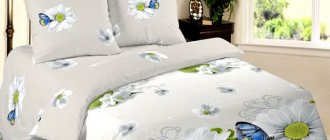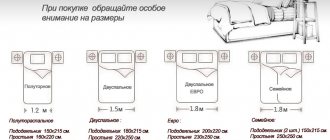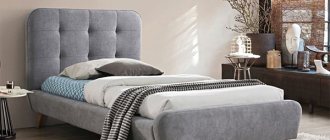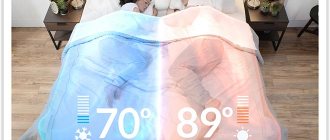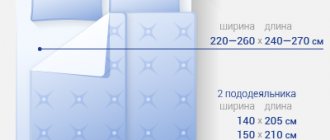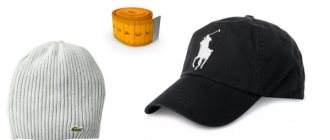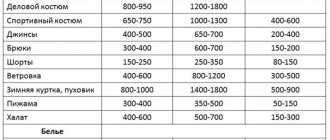How to choose a duvet cover?
Buying a duvet cover is a topic that requires attention and consideration of some nuances.
If you understand how wide the size range of double blankets is, the seller’s words “double”, “will fit” will not say anything. The choice is made, if possible, with a small supply of material for shrinkage (after washing); you need to take into account the specific dimensions of the existing blanket (especially the length). When purchasing, it is important to pay attention to the composition of the material. It’s good if it’s natural textiles with plain weave threads: their shrinkage is more uniform
Twill weave is diagonal. When the duvet cover threads shrink, the fabric may become skewed. In other words, chintz shrinks more, its structure is looser than that of satin or calico. Calico is denser, such a duvet cover is heavier, but more tensile, therefore it has a significant service life.
Synthetics are also undesirable: they have many positive qualities, but they can be allergenic, often do not absorb moisture well and do not allow air to pass through.
Duvet cover size
The bed linen set is selected based on the size of the blanket. The size of the duvet cover should match the size of your comforter. If you don't already have a duvet, choose a set with a duvet cover that covers the width of your bed.
Be sure to choose a size with a small margin, this will allow the blanket to be evenly distributed inside the duvet cover without forming lumps or free space. By the way, blankets and duvet covers produced under the DOBRO HOME® brand have special garters in each corner so that the blanket does not “run away” inside and always lies flat.
Peculiarities
Thanks to advances in the textile industry, there are many options for blankets. Features of bed linen include size, type of filler, and level of heat.
Size
The dimensions of single blankets vary depending on the age category. They produce blankets for children, teenagers and adults in blanket models. The size of a textile item is an important parameter on which convenience and comfort will depend.
Filler
Before the advent of synthetics, blankets were filled exclusively with natural raw materials. This had a negative impact on people who had allergies. Modern industry allows you to choose underwear based on personal needs.
There are several types of fillers.
- Down and feather. This filler retains heat and allows air to pass through well. The soft, light texture makes it pleasant to the touch. A higher percentage of down increases softness and airiness. The feather makes the filler heavier, making it more elastic. Blankets with soft filling should not be washed frequently.
- Wool. This material has high thermal insulation properties. Wool absorbs moisture while remaining dry to the touch. Some blankets with wool filling can be washed in a washing machine. Others require careful manual care.
- Polyester. Synthetic filler, similar in properties to down. Thanks to its excellent thermal insulation properties, a comfortable microclimate in the bed is maintained. Blankets with polyester filling are ideal for allergy sufferers. This material has hypoallergenic properties, and synthetic bedding can be washed frequently at a temperature of 60 degrees. After this treatment, dust mites die, which reduces the risk of an allergic reaction.
- Bamboo fiber. This material ensures rapid evaporation of moisture. Most often, bamboo is added to polyester in a 50/50 ratio.
Heat level
Some people just can’t stay warm under a thick blanket, while others feel hot under a thin one. That is why modern textiles are divided according to their heat level. This allows you to create the most comfortable sleeping conditions.
Blankets are divided into categories.
- Cool. Designed specifically for people who feel hot under a standard blanket. Lyocell fibers contained in the filler increase breathability and moisture absorption. An unusual solution in the form of wax-impregnated viscose fibers allows you to maintain the level of body heat at the same level. When the body temperature rises, these fibers “absorb” heat; when the heat level decreases, they release it.
- Lungs. This blanket has a thin layer of filling. That is why this option is perfect for people who experience discomfort under warmer textiles.
- Warm. These models have a thick layer of filler. This option will be invaluable if the room is cool.
- Very warm. The blankets are made specifically for those who are constantly cold. This option is also suitable for poorly heated rooms. The maximum layer of filler will help create comfort for a full, healthy sleep.
Standard sizes of duvet covers, table
You can see all the current sizes of duvet covers (standard), which are available in the table below:
| Dimension | Length and width (cm) | |
| Children's | For newborns, children up to 1 year | 90x120, 100x120 |
| From 1 to 6 years | from 110x140 to 140x140 | |
| Schoolchildren, teenagers | lorry fits | |
| Double/single | from 140x200 to 173x215 | |
| Double | from 175x210 to 180x220 | |
| Euro | from 200x200 to 217x240 cm | |
| Euro-maxi | from 220x240 to 240x240 | |
| Family or duet – 2 duvet covers | from 140x200 to 173x215 (each) |
Children's
The quality of a child’s rest directly affects his mental and physical well-being
In order for the awakened child to joyfully greet the new day, it is important to properly arrange a place to sleep and choose the right bedding. Many sets are sold together, which makes the choice much easier for many mothers
For newborns and babies up to 1 year in a crib: 87x117, 90x120, 102x120. Depending on the individual characteristics of the child, the size of the blanket cover may vary up or down. But you need to carefully ensure that the bed linen is not too loose and the blanket does not “dangle”, otherwise the child may get tangled in the fabric. The dimensions of a children's duvet cover for a child from 1 to 6 years old are: 110x140, 110x145, 112x147. The indicators are typical for a regular rectangular blanket. But there are also square ones (for example, 140x140 cm). The market offers a wide selection of both blankets and duvet covers, so parents can find the most suitable set for their child. One-and-a-half models are suitable for schoolchildren and teenagers, for example, 140 by 200 or 145 by 210 cm. In adolescence, children grow unpredictably: some grow tall, others are in no hurry
Therefore, when buying a set of bed linen, it is important to take into account the size of the blanket, bed and the height of the child.
Single duvet cover size
Among manufacturers, the concept of “single” does not exist. This name has caught on exclusively among consumers, while a 1-bed duvet cover completely matches the parameters of a one-and-a-half duvet cover (see below), both in length and width.
Size of one-and-a-half duvet cover
There are a large number of options from 140x200 to 173x215 cm. Thanks to this, you can choose a duvet cover for any model of a 1.5-sleeping blanket. The most popular are: 140x200, 143x215, 145x210, 145x215, 147x215, 147x217, 150x200, 150x210, 150x215, 152x222, 160x200, 160x210, 160x220 , 172x205, 173x215 centimeters.
Double duvet cover
Suitable for double quilt. Length and width from 175x210 to 180x220 centimeters. A modern 2-bedroom standard assumes the following sizes: 175x210, 175x215, 175x217, 177x215, 180x200, 180x210, 180x215, 180x220 cm
Duvet cover size Euro
One of the most popular is the Euro size. Includes products from 200x220 to 217x240 centimeters. Suitable for wide family beds with Euro duvet. All sizes: 200x200, 200x215, 200x217, 200x210, 200x220, 205x215, 205x220, 215x220, 217x240 cm
Euro maxi (King size)
This option is also called royal. The dimensions of wide maxi beds exceed standard ones, which creates additional comfort for a restful sleep. The king-size duvet cover is correspondingly larger than all those presented above: 220x240, 220x245, 240x240 centimeters.
Family size, or Duet
Family models go on sale with two one-and-a-half duvet covers. This option is intended for married couples who prefer to cover themselves with different blankets. The size of each duvet cover in a family bedding set is exactly the same as that of a single bed: width from 140 to 173, length from 200 to 215 centimeters.
Reference
: The first mentions of duvet covers date back to the first half of the twentieth century. At that time, only rich people could purchase it, because they were made from expensive materials: cambric, damask, natural silk. However, now this item has become firmly established in household use and is available to people with different income levels.
Standard sizes
The most popular set of bed linen is called “Euro one and a half”. Its size is 155 × 215 cm
The standards for one-and-a-half-bed sets are as follows:
- domestic manufacturers are accustomed to a different standard, namely 140 × 205 cm;
- relatively rare ones include 160 × 205, 160 × 215, 160 × 220 and even 172 × 205 cm; when purchasing, you should take into account possible problems with purchasing suitable sets.
The standard width of a semi-truck can be considered a line of sizes from 140 to 160 cm. The length can be found from 205 to 220 cm. When purchasing a new blanket, you should take into account the sizes of existing duvet covers, and in case of drastic changes, also purchase suitable bedding sets at the same time.
Popular models
Despite the wide variety of options, most often buyers prefer one and a half sizes. It attracts both single people and married couples, especially those in which each partner likes to sleep under a personal blanket. Special bedding sets called family sets are also available for sale. They just include two duvet covers measuring 1.5 m.
You can also think about buying a lorry and a half for children, especially if children’s sets are already becoming too small for them. Manufacturers for such buyers can offer special teenage sets that include a duvet cover of appropriate sizes. If we consider the modern assortment of bed linen, it turns out that it is the one-and-a-half models that are presented today in the largest number of options.
Not everyone knows that even the category of one-and-a-half blankets has its own classification. This allows each customer to choose the size of blanket that suits their needs. And you should not neglect this point, because the level of comfort during rest and sleep depends on it.
Ideal bedding parameters
When a blanket is purchased, it’s time to take care of high-quality and comfortable bedding. You can easily get confused in the assortment, since modern textile stores offer a variety of sets, sizes, which differ in the set of accessories, as well as the dimensions of individual items. Before you go shopping for bed linen, you should determine what exactly you need. Nowadays, bed linen is more common and is sold as a set. It includes a sheet, duvet cover, and a couple of pillowcases. You need to know exactly the size of not only the bed, but also the blankets. This will give you the opportunity to choose bedding that will create a comfortable feeling when sleeping.
One-and-a-half-bed sets are ideal for both one person and a couple. A duvet cover often measures 2.15*1.43 meters, and a sheet measures 2.14*1.45 meters. Pillowcases can be very different, but as a rule, their dimensions are 0.7 * 0.7 meters, which corresponds to a regular pillow. The dimensions of the kits may vary.
The main indicator here is the country of origin, and you should take a closer look at each of the items in the set in order to figure out which bedding will be ideal for you:
- Pillowcase - the size of such an item from a bedding set can be 0.6*0.6, 0.7*0.7 and 0.5*0.7 meters. You should choose it strictly according to the size of your pillow. The pillowcase should not be very tight or loose. This can cause poor sleep.
- Sheet - here the size is determined by the size of the bed, and the sheet should be 0.2 meters larger than the mattress. The most popular dimensions are 1.6*2.1 meters, and another 1.5*2.15 meters.
- Duvet cover - when choosing, you should remember that duvet covers should be longer than a half-length duvet. Ideally, the length of the duvet cover will be 0.1 meter longer, and a regular one-and-a-half duvet cover will have dimensions of 1.5 * 2.1 meters, but there are also 1.5 * 2.15, as well as 1.6 * 2.2 meters.
The choice of a single-size bed linen set depends not only on the parameters and type of bed, but also on the size of the product itself. The duvet cover should be a little looser, and if it is smaller, the duvet will be placed in lumps, which will deprive you of a healthy and sound sleep.
How to measure everything correctly
The “standard” size of a one-and-a-half blanket for adults in Russia is 1.4*2.05 meters (this is the most popular). This size will correspond to the classic large bedding, which is produced by Russian manufacturers. This has been preserved since Soviet times. The most important thing in choosing bed linen is to avoid making a mistake with the size of the duvet cover, and for this it is important to take measurements of the duvet. Length and width are important, but don't forget about the thickness of the blanket. Common sizes for one-and-a-half blankets are 1.4*2.05, 1.55*2.15, 1.6*2.05 and very rare – 1.6*2.2 meters.
Children's mattress size chart
| Standard sizes | Length cm. | Width cm. |
| In a pram or cradle for newborns | 80-95 | 40-50 |
| In a crib for newborns | 120-140 | 60-70 |
| In a cot for children from 3 years old | 140-190 | 70-80 |
| In a crib for teenagers | 190-200 | 80-120 |
Before purchasing, you should accurately determine its size. To do this, you need to correctly determine the internal size of the bed by measuring the length and width along the side. You should not rely on standard sizes, because they can fluctuate quite a lot, and a deviation of 5-10 cm will make the mattress unusable.
Mattress for a stroller or cradle for newborns
The smallest mattress in a person’s life is a product for a baby stroller or cradle. Its standard dimensions can range from 40x80 cm to 50x95 cm. Such models are not endowed with anatomical qualities, but perform the function of providing a newborn with a flat and hard surface.
At the same time, it becomes a buffer, smoothing out unevenness on the bottom of the stroller. Their dimensions must strictly correspond to the inner surface of the stroller or cradle, because even minor deviations will lead to noticeable discomfort for the baby.
Mattress for a crib for newborns
In most cases, parents prefer to buy a crib rather than a cradle for their newborns. Unlike a cradle, which can be used for no more than 1-1.5 years, it is already used until the child reaches 3 years of age.
If you buy a crib, you will also need to buy a mattress for it, the size of which will be 60x120–70x140 cm. It will also become a low, breathing space between the bottom of the bed and the baby’s body, while maintaining sufficient rigidity of the sleeping place.
Crib mattress for children over 3 years old
At the age of 3–4 years, the child will feel cramped in his first crib. Therefore, parents will have to purchase a larger bed. In order to save money, children can immediately purchase a large single or one-and-a-half bed.
However, for the developing skeleton, this option is not entirely correct, since the requirements for rigidity will change twice more. A better solution would be to purchase a bed and mattress ranging in size from 70x140 to 80–190 cm.
At the age of 4–5 years, children still require a certain rigidity during sleep. At the same time, they become quite active, starting to jump and run everywhere, including on the bed. Expensive orthopedic models may not be able to withstand such a load, so for children aged 5–10 years it is better to purchase high-quality spring options.
Bed mattress for teenagers
Adolescence is a time of active growth and final formation of the spine. Many teenagers manage to grow to the size of an adult, or grow at a significant rate. Changing their sleeping place will no longer be a desire, but an urgent necessity.
The size of mattresses in a bed for teenagers will be determined not only by height indicators, but also by capabilities, since a bed for them can already be purchased, either a single or a one-and-a-half-bed. The width of standard sizes will be 80–120 cm, and the length – 190–200 cm. The preferred type will be orthopedic. He will no longer suffer from children's pranks and will be able to fully perform his function.
Height of mattresses for children
Height for children's beds is also a significant criterion. It is determined both by the requirements for rigidity and the internal filling of the mattress. In some cases, the height is determined by the inner side of the bed; in order to avoid injury, it must rise above it by at least 5 cm.
In turn, there are age restrictions on height. Thus, the parameter of mattresses for children under 3 years of age should be from 6 to 10 cm, the height of spring mattresses for younger schoolchildren is 10–20 cm, the height of orthopedic mattresses for teenagers is 14–20 cm. In this case, some excess of the parameters for spring mattresses is allowed and orthopedic models. Thinner ones can be used as mattress covers or bedspreads for sofas.
Standard bedspread sizes
There are several standard sizes of bedspreads. The list of available options should start with the smallest - a blanket for newborns. Its size should be 80x100 cm. Such bedspreads should be soft and pleasant to the touch. Due to this, the risk of irritation on delicate baby skin is eliminated.
There is also a so-called children's size (110x140 cm). This option is ideal for beds that are intended for children aged 3 to 12 years.
Next in the size chart is a 1.5-bed bedspread measuring 140x200 cm. When choosing this option, you should take into account that the bedspread on the sofa hangs slightly on the sides and does not reach the floor.
On single-and-a-half beds, double bedspreads measuring 170x210 cm can also be used. In some countries, these products correspond to the size 130x200 cm.
Euro bedspreads of a size corresponding to 200x220 cm are considered a multifunctional option. These products can even be used as warm blankets or spectacular throws on double beds. They can also be used as soft and durable bedding for an outdoor picnic. There is another size - euro maxi (220x240 or 240x260 cm).
How to choose the right size?
A few simple tips:
- Before you go to the store to buy a blanket, you first need to find out the size of the bed and duvet cover. It will be very disappointing if, after spending time and money on a huge blanket, it turns out to be too big for the cover. Of course, there can be no talk of any comfort in this case. A married couple should consider purchasing a family or euro set and a matching duvet cover and pillowcase.
- In the first years of this century, a special GOST was issued that regulated the sizes of bed accessories. In particular, they were classified into European, children's, single and other types, which are described in the previous sections of this article. The buyer should take note that the sizes indicated on the packaging are presented in two types: European (indicated in letters) and Russian (indicated in centimeters).
You should definitely pay attention to what exactly a blanket is filled with.
The weight of a blanket directly depends on its dimensions and what it is filled with. It doesn't matter what kind of padding a buyer might like. What's more important is that the blanket maintains the temperature of the sleeping person's body. Bamboo and eucalyptus fibers are universal fillers that can warm in cold winters and cool in hot summers.
But there are many people who, out of habit, buy two sets - for winter and summer.
Having knowledge of what size standards for blankets have, choosing the right bedding will not be difficult.
If you have any doubts about what material the blanket is made of, you should carefully study the label. There, as a rule, everything related to this model is described in detail: dimensions, composition, manufacturer, care instructions.
However, if the consumer is not sure how to properly wash this or that linen, a paid dry cleaner is always ready to provide this service. Or you should buy a synthetic blanket, which can be washed very rarely, at least once a year (preferably in a gentle mode, so as not to accidentally damage the product).
It is worth mentioning the peculiarities of choosing children's and family specimens. When purchasing a model for a crib, it is recommended to take into account that babies have a habit of throwing off the blanket. It’s worth taking a copy “with reserve” for tucking a blanket under the mattress. Samples with Velcro and laces will also work.
And if the buyer purchases a one-and-a-half blanket, he can easily add “family sets” to it. They imply the presence of a pair of duvet covers and wide sheets.
Single and semi-double rooms
The use of the expression “single blanket size” is not entirely correct. The fact is that even during the times of the “power” of GOST standards there was no such concept. The documents specified only the width and length of the “single” sheet, while the duvet covers were designated as “one and a half” and the size was 143x215 cm. Single sets were on sale, of course, but they differed from 1.5 bedroom sets only in the sheet: 120x203/214 cm versus 150 /155x210 cm.
Today, the most common size of a one-and-a-half blanket, the standard is 140x205 cm. It is suitable for a duvet cover of 145x215 cm, included in the set of 1.5 bedroom (in the Russian sense), teenage and family bed linen. Blankets 145-150 cm wide are also quite common. Anything larger than 150x210 cm is quite difficult to find on sale. Roughly speaking, in a store where about 400 models are presented (in total), there will be only about a dozen products with parameters 160x200.
Types and standards
Single and one-and-a-half beds
The set includes:
As the name suggests, the set is designed for one person, but now traditional single sets are becoming increasingly rare.
1 to 5 bedroom sets are very popular, which are suitable not only for 1 person, but also for a home couple who sleeps in the same bed.
Double and Euro
A double set differs in the increased size of the duvet cover and sheets, and such a set can include two or four pillowcases and one duvet cover.
The set is suitable for both singles and married couples.
The Euro size differs from the double size only in larger sizes, the equipment remains exactly the same.
Family
Family models are equipped with 2 one-and-a-half duvet covers.
Designed for married couples who prefer to cover themselves with various blankets.
Euro Maxi
The size of the duvet cover in this set is 220x240 cm, and the size of the sheet can reach 260x260 cm.
Pillowcases in Euro maxi sets come in two standards: 70x70 and 50x70 and are traditionally supplied in the amount of 4 pieces.
Classification
The classification of bed linen by size in Russia and in Europe differs not only in numbers: European linen is marked with symbols in British language.
Sizes of one-and-a-half bed linen: standard
The parameters of bed linen for one and a half beds are variable, since manufacturers often adhere to individually designed patterned mesh. However, they cannot be smaller than the dimensions of a semi-truck determined by GOST.
| Name of bedding | Double duvet cover | Single pillowcases | Single bed sheet |
| Dimensions before shrinkage | |||
| 145×210 | 60×60 (square) | 150×215 | |
| 150×210 | 50×70 (rectangular) | 160×210 | |
| 150×215 | 70×70 (square) | 160×215 | |
| 150×220 | – | 160×240 | |
| 160×210 | – | 180×240 | |
| 160×220 | – | 180×260 | |
| Average weight of a bedding set | 1500–1600 | ||
The approximate size of a 1.5-bed duvet cover made in Europe or America is 145x210 cm. This is the most common option. It is suitable for a 1.5-sleeping blanket with dimensions of 140 by 205 centimeters. Imported sheets and pillowcases can have dimensions of 183×274 and 51×76 or 65×65 cm, respectively.
The ideal duvet cover is 5-6 cm wider and longer than a 1.5-size duvet. If in fact the size of a one-and-a-half duvet cover turns out to be larger than indicated on the packaging, it means that the manufacturer has provided a small margin for shrinkage.
On a note
The inscription on the Single or 1-bed label means that the sleeping set includes one pillowcase. Sets from German and Austrian manufacturers never include a sheet. Italian textile factories produce duvet covers already 140 cm.
To determine the appropriate bedding parameters, arm yourself with a sewing tape measure and take measurements of the bed, pillows and blanket. If you are using an orthopedic mattress, measure it too.
Typical dimensions of bedding (dimensions in cm):
| Dimensions of a 1.5 sleeping blanket | 140×205 | 145×215 | 150×205 | 150×215 |
| Mattress dimensions | 100×190 | 115×195 | 120×200 | 125×200 |
The parameters of the sheet are determined not so much by the dimensions of the bed as by the mattress. The ideal option is when it is 30–60 cm longer and wider. For example, on a 125x200 cm mattress it is better to put a 150x215 cm sheet on it. The larger it is, the easier it is to tuck it in.
When choosing a fitted sheet, do not add extra centimeters to the width and length. It should perfectly match the sleeping area. On the packaging of such products there is one more parameter - the height of the side, which should be equal to the height of an orthopedic or regular mattress. It is designated as follows: 190×90+30 cm, 190×90, side 30 cm.
Pillows produced in the Russian Federation have the same length and width. For square pillowcases, 70x70 cm are suitable, and for rectangular ones, 50x70 cm.
If a one-and-a-half bed has non-standard parameters or is equipped with an orthopedic mattress that is too large, you can purchase bedding separately, rather than a 1.5-bed set. Or order individual tailoring of one-and-a-half-size bed linen.
© 2021 textiletrend.ru
Custom size options
Non-standard sizes of bedding are those that do not fit into any generally accepted standards. These are usually blankets that are custom-made or purchased in another country. The owner of such a curiosity will have to work hard to find suitable bedding. The best option would be to take measurements of the bedding and order linen tailoring from a studio.
In many European countries (Italy, France, Germany), the ratio of 180*220 is considered the standard for blankets. There are also specific parameters characteristic of a particular country. So, in Belgium you can easily find blankets with parameters 170*210, in Italy – 210*250, in Great Britain – 300*250. They should not be perceived as a problem at all, because linen is ordered from any studio, the most important thing is the harmonious combination of the item with the furniture and interior.
Single bed linen sizes
The standard formats of Russian and foreign products are very different, since each country and continent has its own standards and requirements for the manufacture of bedding and furniture. According to domestic GOST, a set for 1 double bed consists of the following indicators:
- Pillowcase 50 x 70.
- Duvet cover 135 x 200.
- Bed sheet 110 x 200.
A single set is often purchased for children or the elderly, therefore, in addition to the size, you need to pay attention to the quality of the material. Children's underwear must have high hypoallergenic properties, be an environmentally friendly product, and the hygroscopicity of the product (moisture absorption) is also important. Russian manufacturers produce sets for babies in different size grids, because children grow and, therefore, they first need a nursery size, then a teenage one. The approximate standard for baby pillowcases is 40x60, duvet covers 100x140, sheets 100x138.
The dimensions of foreign bedding differ from domestic ones, because they have different formats of beds and mattresses. Available in two directions:
- European. Adult size pillowcase – 51x76, sheets 90x190, duvet cover 145x200. Children's pillowcases 40x60, sheets 60x120, duvet covers 100x120.
- American. Adult size pillowcase – 51x76, sheets 99x191, duvet cover 170x220. Children's pillowcases 40x60, sheets 71x132, duvet covers 101x121.
In our catalog you will find a wide variety of options for children's bedding - from various materials, all types of colors!
Advantages of the size range
Double blankets are universal. Due to their size, they are multifunctional items. Such blankets eliminate unnatural postures of users associated with a lack of covered area.
Such a product may be:
- A cozy and spacious cocoon that envelops the user from all sides while resting or sleeping.
- A comfortable warm blanket-plaid that can be used to cover the surface of the sleeping place (as a bedspread).
- An excellent mattress cover that covers the surface of the mattress, making it smoother and softer.
- The “right” type of blanket, providing not only comfort, but also benefits with medicinal properties (models made from natural wool).
Double blankets have many advantages.
They not only differ in suitable sizes, but also:
- They have a wide range of modern raw materials of natural, synthetic or mixed origin. The raw materials are of high quality.
- They stand out noticeably against the background of more compact analogues, covering the surface of the furniture with a margin, which looks impressive and stylish.
- They are often not only functional bedding, but also bright accents in the bedroom.
- They have a wide range of models, made in open and closed types, with one or two working sides or in the form of double products - according to the “two in one” principle.
- They are distinguished by a variety of colors, which allows the buyer to choose an option based on their own preferences.
- Due to the variability of measurements, you can buy a product in a store with a limited assortment, choosing the most suitable option.
- They help out the owner of the house in the event of guests arriving, sheltering two or even three users (parents with a small child).
- Depending on the raw materials and size used in production, they have different prices, which makes it possible to decide on a purchase based on your budget and taste.
European standards
Standards in Europe differ significantly from Russian ones. The fact is that abroad a single bed is slightly larger than in Russia. This is why bed linen sizes are generally larger. Thus, the most common European standard is 155x215 cm. There is also a non-standard option: 195x215 cm.
Some countries have their own standards for a single duvet depending on the standards for a single bed.
- In England it is 200x250 cm, 230x250 cm, 280x250 cm, 300x250 cm;
- In Belgium - 170x210 cm and 190x230 cm;
- In Spain – 210x250 cm.
Germany, France, Italy adhere to the basic European standard. This must be taken into account when purchasing textiles from a foreign manufacturer.
Duvet covers
This is something without which using a blanket is not possible. Therefore, we will dwell on them separately. Products are divided into several types, respectively, PBC, to which they fit in width and length. You can see the general range of parameters in the table below, but for now let’s look at the most popular ones. Let's start with the size of the one-and-a-half duvet cover used in 1.5 bedroom and family PBCs. The range here is quite large (from 140 to 165 cm), but products 145x215 cm are the most popular.
The size of a 2-bed duvet cover starts from 175x210 cm, which is also the most used in Russia. In other countries, its role is played by products marked as euro, and with parameters from 200x220 cm. Blankets for them are required of appropriate dimensions. By the way, imported PBC sometimes include only a duvet cover and pillowcases, and the sheet is purchased separately.
Important: a single duvet cover does not exist; its role is played by a one-and-a-half duvet cover. It is also included in family bedding sets (2 pieces). In both cases, the product parameters are standard and vary depending on the manufacturer and country of origin. There is only one rule: Russia and China tend to decrease (140 cm width on average), Europe tends to increase (150 cm width on average).
Main sizes of duvet covers, table:
| View | Parameters, cm |
| One-and-a-half-sleeper (aka blanket for family size KPB) | from 140x205 to 165x210 |
| Double | from 175x210/215 to 180x210 |
| Euro standard | 200x220 |
| Euro-maxi | 220x240 |
| Children's | From 100x150 to 115x155 |
The main differences between Euro blankets
The identification of a separate category “European standard” is quite arbitrary. There is no single and mandatory standard; each European country has its own patterns, and the parameters do not always coincide. As a result, this has led to the fact that in recent years, in accordance with the wishes of customers, many Russian manufacturers have expanded the size range, adding models with new, more acceptable proportions and sizes. Due to the fact that factories have begun to sew products for a new format, today you can purchase a blanket with almost any parameters, even significantly exceeding King Size blankets.
The competitive advantage of Euro size blankets is:
- the ability to expand your personal comfort zone - it is easily enough for two, tall or large people;
- a large selection of models - by type of material, design, fillers, colors, surface structure;
- suitable for most modern beds, fits into the interior of the room - allows you to beautifully make up even a huge bed, creating a visual effect of order, a feeling of coziness and comfort;
- the ability to choose a perfectly suitable set of bed linen (except for non-standard sizes), in particular a matching duvet cover.
The disadvantages include a fairly high price, which is explained by the high cost of a high-quality Euro blanket - the cost of production, raw materials, delivery and sale of finished products.
Review of manufacturers
To have a more detailed idea of the size and appearance of blankets, you can take a closer look at the products of trusted brands that have a lot of customer reviews:
- Dargez - a wide range of blankets (more than 1000 items) of different types, including all-season types of one-and-a-half, double and Euro sizes with different types of filler (siliconized polyester fiber, cotton, microfiber “Swan Down”, down, half-down, Tencel, “Vaitel”) and different cover fabrics.
- Togas is a line of closed-type quilted models of different sizes filled with natural wool in satin, microfiber in anti-stress textiles, Austrian and Masurian goose in cambric, cashmere in silk, with a wide range of prices (from 4,200 to 80,000 rubles and above).
- “Ecotex” - closed quilted models of one-and-a-half, double and Euro sizes with a budget price of a lightweight and standard plan, made of bamboo and DownFil microfiber, camel wool, merino, equipped with a cotton cover made of teak, poplin, satin jacquard, percale, impregnated with aloe vera extract .
- Kariguz - a variety of models: from lightweight to very dense and warm for one, two users and euro sizes, made from natural raw materials (camel and sheep wool, goose down, cashmere, bamboo) and synthetic filler for different seasons, having cassette, quilted and combined type of manufacturing.
- “Lezheboka” - three lines of one-and-a-half and double size blankets (“Standard”, “Elite” and “Premium”) made of bamboo fiber, camel and sheep wool, Mongolian yak down, the latest generation Korean siliconized fiber with a hygroscopic and soft hypoallergenic cover.
- Natures - products of a domestic company in one-and-a-half, double and Euro sizes, all-season models made from natural Australian merino wool, goose down and fine feathers, bamboo and hollow siliconized fiber, characterized by an affordable price and a natural cotton cover.
- Mona Lisa - inexpensive blankets in three sizes, filled with a soft layer of artificial silk with viscose, bamboo, camel hair, cotton, polyester with a cover made of natural or mixed fabric (mix of polyester and cotton).
- Primavelle - hypoallergenic models for different seasons made of down (including swan), wool, bamboo, eco-fiber, silk, phyto- and synthetic filling in standard sizes for adults for single, double and Euro beds, packed in cotton covers in pleasant colors.
To learn how to choose the right bed linen size, watch the following video.
The dependence of the weight of the blanket on the type of filler
Manufacturers offer a wide selection of fillers. They differ in a number of characteristics, for example, weight, warmth, price.
Blankets are:
- With natural filling: Down;
- Wool;
- Bamboo;
- Silk.
- Duvets are quite voluminous, but light. The weight of a blanket measuring 2.0 m by 2.2 m is about 900 grams. Wool blankets are heavy. They retain heat perfectly, so you don’t have to worry about freezing even in the dead of winter. However, they are not suitable for everyone. Some say that they feel discomfort under such a blanket due to the “pressing” effect. The average weight of a double wool blanket is 1800 grams.
What to look for when purchasing
Have you already chosen the right size for the blanket you are going to buy? Now take your time
In order to buy a quality item that will serve you for many years, before purchasing, be sure to pay attention to the following important nuances:
presence of the manufacturer's trademark and its contacts on the tag; filler composition: synthetic or natural. It must be safe, bactericidal, hypoallergenic and durable; the strength of the case. It is desirable that it be made of natural fabric: satin, cambric, percale, teak, natural silk
Such a case should glide gently in your hand, be smooth and not cling to the skin. the filler must be securely fastened using a patterned or cassette stitch, preventing it from moving in the case; storage requirements; care features; cost of the product - if this is important to you.
So, we have told you in detail about all the size ranges of adult and children's blankets, their features and nuances. They gave important recommendations on how to purchase them. Now you can easily choose the right blanket that will fit your bed perfectly, ensure good air circulation and make your sleep comfortable and restful at any time of the year.
And the table of blanket sizes presented in our article will become your assistant in the wide world of offers from Russian and foreign manufacturers. We wish you happy shopping! Next Useful information: Which is better for bed linen: calico or satin
Nuances when purchasing
Some tricks will help you visually determine the quality of a blanket and not get deceived, as well as how to avoid common mistakes when purchasing, and also see reviews: which blanket is better to choose.
How to choose a quality blanket:
- Sewing assessment: the filler should not appear in the seams and generally reveal itself in any way, the lines are even, preferably a cassette stitch (for feather versions) or a diamond stitch (for all others). The filler can be padding polyester or holofiber.
- Verification of documents: in fact, everyone knows that it is necessary to ask for a quality certificate, but few have seen it in person. It is also necessary to pay attention to the label and packaging of the product itself: a reputable manufacturer always takes care of these little things to ensure that the product is safe.
Some companies are still trying to make the packaging more elegant in case of purchase as gifts.
Avoid:
- damaged or frankly homemade packaging;
- unclear labels where it is impossible to recognize the manufacturer’s brand and basic information about the product;
- care recommendations should also be comprehensive.
Choose any color you like, the main thing is to check the quality of the coloring.
Regarding the size: there is no need to choose non-standard blanket options, so as not to have to worry about finding suitable sleeping sets later. Rarely, there are complaints about the blanket’s too rich color, which can show through through light-colored linen; in order to avoid such embarrassment, it is better to think about this factor.
There are many models of cozy and high-quality one-and-a-half blankets on sale. All sizes of a one-and-a-half duvet cover can be viewed in this article. The material used for sewing, the type of filling and seasonality can be selected to suit every taste and financial capabilities. An important selection criterion will be the dimensions of the blanket, which are best chosen from the standard line so as not to create difficulties when purchasing bed linen.
You can see photos about the types of flannelette blankets available here.
Which blanket is better to choose for sleeping?
The textile industry offers its consumers a wide selection of bedding of various models and quality levels. With so many options to choose from, how do you choose a good blanket that's right for you? The article provides recommendations and advice on the correct selection.
When asked which blanket to choose for relaxing and sleeping, you can confidently answer that the main criteria are the quality characteristics of the cover and filling. Important points are also:
- correctly selected size;
- for whom is it intended - an adult or a child;
- how it will be used - for its intended purpose or as a decorative element.
Selection by season
First of all, it is worth noting that it is better to buy a quality product, even if it costs much more. This thing is guaranteed to bring you a restful, healthy sleep and will last longer. So when purchasing a product, it is first of all better to take into account not the price, but the sanitary and hygienic requirements:
- hygroscopicity;
- hypoallergenic;
- breathability;
- thermal conductivity.
For the winter
Which blanket is better to choose and buy for the winter? A good winter blanket, of course, should be light, comfortable and warm. Thus, for the cold season, purchase products that have the ability to retain heat. Therefore, the best for winter are:
- fluff;
- wool;
- padding polyester;
- holofiber;
- cotton wool
All these materials have excellent heat-retaining characteristics.
For summer
For the summer, a light blanket, such as bamboo, would be an excellent option. Which blanket to choose for hot weather to feel pleasantly cool? Silk products are the favorite in this case. They are smooth and have pleasant cooling qualities.
On cool summer nights, wool blends will be indispensable. Despite the presence of wool, they are light, thin and do not cause discomfort.
For all seasons
In an unstable economy, the question of which blanket is best to choose for all occasions becomes relevant. Textile manufacturers have taken care of this too. If it is not possible to have a separate item for each season, then you should choose a universal blanket. It is also suitable for practical people, small apartments and studios where there is no place to store things.
Such products include a double-sided model, one side of which is wool or fur, and the other is fabric. Another interesting solution for all seasons is the double model. It consists of two halves fastened together. This all-season blanket keeps you warm in the winter, and when summer comes, just unfasten the warm half and use the thinner one separately.
Determining personality and size of a one-and-a-half blanket
One-and-a-half products are used to a greater extent in families whose members prefer to sleep under a separate blanket.
Such a shelter is completely sufficient to provide comfortable sleep and rest for one person. Accordingly, linen for such products is also selected in single-and-a-half size.
Size of a one-and-a-half blanket and common parameters:
- 155x215 cm - the practical and most common size of one-and-a-half-piece products, recognizable as Euro-one and a half;
- 140x205 cm - “Soviet” standard blankets for small beds;
- 160x205 - not a very common modification, most often purchased for children;
- 160x220 cm - a very rare option for one-and-a-half blankets.


